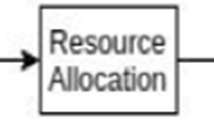Abstract
Motivated by experiences of coalition military forces in Iraq and Afghanistan, we analyze the allocation of route clearance teams (RCTs) to search for and neutralize improvised explosive devices (IEDs) on roadways traveled by military convoys. We model the interaction of a single RCT and a single convoy operating over a given roadway. Our goal is to reduce IED risk by improving coordination between the RCT and the convoy. We treat the distribution of IEDs along the road prior to the passage of the RCT as a non-homogeneous Poisson process. The RCT finds and clears IEDs according to a Bernoulli process. Enemy forces may emplace (reseed) additional IEDs in the temporal gap between the RCT clearance sweep and the arrival of the convoy. IED risk is defined as the expected number of IEDs encountered by the convoy. We identify certain characteristics of optimal RCT schedules including: the shape of the IED intensity function and the speed of reseeding substantially dictate the RCT schedule that minimizes IED risk; the more rapid the IED reseeding, the more critical is conformance to the optimal RCT schedule; an RCT having inferior detection probability, by employing superior scheduling can sometimes reduce convoy risk more than a less well scheduled RCT with superior detection probability; a discretized highway version of the problem can be efficiently optimized. We also briefly discuss applications of this model to the more complex problem of allocating several RCTs to protect a number of convoys scheduled to travel on a network of highways.











Similar content being viewed by others
References
Atkinson, R. (2004). Left of the boom. http://www.washingtonpost.com/wpsrv/world/specials/leftofboom/index.html. Accessed March, 2008.
Atkinson, R. (2007). The single most effective weapon against our deployed forces. In The Washington Post Sunday, September 30, p. A01.
Ball, M. O., Monma, C. L., & Magnanti, T. L. (Eds.) (1995). Network routing, Handbooks in operations research and management science (Vol. 8). Amsterdam: Elsevier.
Brook, J. V. (2008). IED’s go beyond Iraq and Afghanistan. In USA today, May 13, 2008.
Cordesman, A. H., & Kocharlakota, V. (2010). IED metrics for Iraq: June 2003–September 2010, center for strategic and international studies (monograph 23 pages), November 12, 2011. Accessed on April 6, 2010 at http://csis.org/files/publication/101110_ied_metrics_iraq.pdf.
Cordesman, A. H., & Lemieux, J. (2010). IED metrics for Afghanistan: January 2004–May 2010, center for strategic and international studies (monograph 24 pages), July 2010, November 11, 2011. Accessed on April 6, 2010 at http://csis.org/files/publication/101110_ied_metrics_afghanistan.pdf.
Caryl, C. (2009). America’s IED nightmare. In Foreign policy, December, 2009.
Dantzig, G. B., & Ramser, J. H. (1959). The truck dispatching problem. Management Science, 6(1), 80–91.
DeGregory, K. W. (2007). Optimization-based allocation of force protection resources in an asymmetric environment. M.Sc. thesis. The Sloan School, MIT, Cambridge, MA, June 2007.
Golden, B., Raghavan, S., & Wasil, E. (2008). The vehicle routing problem—latest advances and new challenges (1st ed.). New York: Springer.
Icasualities.org (2011). http://icasualties.org/OEF/Fatalities.aspx.accessed12/28/11.
JIEDDO (2006). Joint Improvised Explosive Device Defeat Organization. Annual report FY 2006. Accessed at https://www.jieddo.dod.mil/.../JIEDDO_2006_Annual_Report_U.pdf. December 28, 2011.
JIEDDO (2010). Joint Improvised Explosive Device Defeat Organization, Annual report FY 2010. Accessed at https://www.jieddo.dod.mil/.../JIEDDO_2010_Annual_Report_U.pdf. December 28, 2011.
JIEDDO (2012a). Counter improvised explosive device strategic plan. Accessed at https://www.jieddo.dod.mil/content/docs/20120116_JIEDDO_C-IEDStrategicPlan_web-MED.pdf. March 20, 2012.
JIEDDO (2012b). Future R & D capability gaps. Accessed at https://www.jieddo.dod.mil/content/docs/20120127_JIEDDO_R-D_Gaps.pdf. March 20, 2012.
Kolesar, P. (2009). Poisson trending of IED event frequencies. Annual technical report, Vol. I (FOUO), George Mason University C4I Center/JIEDDO project, Fairfax, Virginia.
Kolesar, P., Woodaman, R., & Leister, K. (2008). A time series analysis of improvised explosive device incidence. In Red blue interaction modeling research for the joint improvised explosive device defeat organization—final report (FOUO). George Mason University C4I Center/JIEDDO Project, Fairfax, Virginia.
Kolesar, P., & Stimpson, D. (2009). Micro-model of the impact of route clearance teams on the risk of improvised explosive devices to combat logistic patrols. Annual technical report, Vol. I (FOUO). George Mason University C4I Center/JIEDDO project, Fairfax, Virginia.
Koopman, B. O. (1956). The theory of search. Part II. Target detection. Operations Research, 4(5), 503–531.
Koopman, B. O. (1957). The theory of search. Part III. The optimum distribution of search effort. Operations Research, 5(5), 613–626.
Koopman, B. O. (1980). Search and screening. New York: Pergamon.
Kress, J., & Grogger, S. (2007). The domestic IED threat. In Joint armed forces quarterly, December 05, 2007.
Marks, C. E. (2009). Optimization-based routing and scheduling of IED-detection assets in contemporary military operations. MS thesis, The Sloan School, MIT, Cambridge, MA, June 2009.
Metz, F. (2009), Lieutenant general, director, joint improvised explosive device defeat organization, testimony before the house armed services committee, subcommittee on oversight and investigations, U.S. house of representatives. Countering the global challenge of IEDs today and in the future,’ second session, 111th congress 29 October, 2009.
Morse, P., & Kimball, G. (1950). Methods of operations research (pp. 86–92). Cambridge: MIT Press.
National Research Council (2007). Countering the threat of improvised explosive devices: basic research opportunities (abbreviated version). National Academies Press. Retrieved 10/10/10 at www.nap.edu/open_book.php?record_id_11953.
Pollock, S. M. (1979). Surveillance and search theory. In Haley, K. B., Stone, L. D. (Eds.) Search theory and applications. New York: Plenum, pp. 113–126.
Robb, J. (2007). Brave new war: the next stage of terrorism and the end of globalization. New York: Wiley.
Robb, J. (2010). Journal: open source warfare and IED design innovation, 09 August 2010. Accessed on 4/5/12 at http://globalguerrillas.typepad.com/globalguerrillas/2010/08/journal-open.html.
Ross, S. (1997). Introduction to probability models. New York: Harcourt.
Simchi-Levi, D., Kaminsky, P., & Simchi-Levi, E. (2007). Designing and managing the supply chain (3rd edn.). New York: McGraw Hill.
Stone, L. D. (1975). The theory of optimal search. New York: Academic Press.
Szechtman, R., Kress, M., Lin, K., & Cfir, D. (2007). Models of sensor operations for border surveillance. Naval Research Logistics, 55, 27–41.
Toth, P., & Vigo, G. (Eds.) (2002). The vechicle routing problem. SIAM series on discrete mathematics and applications. SIAM: Philadelphia.
Washburn, A. (1996). Search and detection (3rd edn.). Linthicum: Institute for Operations Research and the Management Sciences.
Washburn, A., & Ewing, L. P. (2009). Allocation of clearance assets in IED warfare. Naval Research Logistics (NRL), n/a. doi:10.1002/nav.20374Wilson,1934.
Washburn, A. R., & Sutter, F. P. (1999). Mine warfare (Chapter 10) In Wagner, D. H., Mylander, W. C., Sanders, T. J. (eds), Naval operations analysis (3rd edn.). Annapolis: Naval Institute Press.
Wikipedia (2010). Improvised explosive device. Retrieved October 10, 2010 from http://en.wikipedia.org/wiki/Improvised_explosive_device.
Wilson, R. H. (1934). A scientific routine for/stock control. Harvard Business Review, 13, 116–128.
Author information
Authors and Affiliations
Corresponding author
Additional information
In memory of Cyrus Derman and Bernard O. Koopman
Rights and permissions
About this article
Cite this article
Kolesar, P., Leister, K., Stimpson, D. et al. A simple model of optimal clearance of improvised explosive devices. Ann Oper Res 208, 451–468 (2013). https://doi.org/10.1007/s10479-012-1126-1
Published:
Issue Date:
DOI: https://doi.org/10.1007/s10479-012-1126-1




